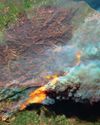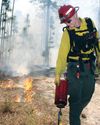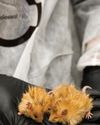Intentar ORO - Gratis
So Long, Saturn
Muse Science Magazine for Kids
|July/August 2017
Cassini’s Marvelous Mission Is Coming to an End.

If you’re under 20, NASA’s Cassini spacecraft has been in space your whole life. If you’re under 13, Cassini has been orbiting Saturn your whole life. Thi robotic spacecraft is about a billion miles (1.6 billion km) from Earth, learning about Saturn’s rings and moons, watching its storms, and measuring its moons.
Scientists have lots of questions about Saturn. Why does Saturn have massive storms that last for months or years? How old are its rings, and how were they formed? Could any of its moons support life? NASA’s Cassini spacecraft is helping scientists answer these questions, and many more.
A SPACECRAFT WITH A SPECIAL BLANKET
As big as a school bus, Cassini is the largest interplanetary spacecraft that NASA has ever built.
Cassini ’s shiny gold-colored foil blanket protects the spacecraft from tiny bits of rock that could damage its sensitive scientific instruments. The blanket also keep the spacecraft warm in the cold vacuum of space. Some of the layers of insulation are made from materials similar to those in bulletproof vests.
The large, white, dish-shaped communications antenna at the top of the spacecraft points toward Earth. Cassini uses the antenna to transmit its pictures and data as radio signals. The signals travel all the way to the Earth-based Deep Space Network—a group of enormous radio antennas located in Spain, Australia, and California. This network also sends commands to Cassini. Traveling at the speed of light, the signals sent to and from Cassini can take an hour and a half to traverse the vast distance between the planets.
Cassini has 12 different science instruments on board, including cameras, radar, a magnetic field detector, and instruments to figure out which chemical elements are present in Saturn and its moons.
Esta historia es de la edición July/August 2017 de Muse Science Magazine for Kids.
Suscríbete a Magzter GOLD para acceder a miles de historias premium seleccionadas y a más de 9000 revistas y periódicos.
¿Ya eres suscriptor? Iniciar sesión
MÁS HISTORIAS DE Muse Science Magazine for Kids

Muse Science Magazine for Kids
ANIMAL FIREFIGHTER TO THE RESCUE
Can animals help manage the risks of deadly wildfires?
3 mins
Muse July 2025: The Story Behind Wildfires

Muse Science Magazine for Kids
FIRE DANGER
WHY THE RISK OF WILDFIRES KEEPS GROWING
4 mins
Muse July 2025: The Story Behind Wildfires

Muse Science Magazine for Kids
The Miller NEW Normal
WHAT TODAY’S WILDFIRES TELL US ABOUT OUR FUTURE
8 mins
Muse July 2025: The Story Behind Wildfires

Muse Science Magazine for Kids
WOMEN AND FIREFIGHTING: A GOOD FIT
Jessica Gardetto is a firefighter. Her father was, too. “I grew up with my dad coming home smelling like wildfire and covered in soot,” she says.
1 min
Muse July 2025: The Story Behind Wildfires

Muse Science Magazine for Kids
What is happening on your fingertips when they get all wrinkly in a hot tub?
—Felix G., age 10, Montana
1 mins
Muse July 2025: The Story Behind Wildfires

Muse Science Magazine for Kids
WHEN the SMOKE CLEARS
THE LINGERING EFFECTS OF THE RECENT PACIFIC PALISADES AND ALTADENA EATON FIRES
6 mins
Muse July 2025: The Story Behind Wildfires

Muse Science Magazine for Kids
PICKING TEAMS
Keep it fair with a strategy that relies on geometry.
2 mins
Muse July 2025: The Story Behind Wildfires

Muse Science Magazine for Kids
SHAN CAMMACK
WILDLIFE BIOLOGIST AND FIRE SAFETY OFFICER
3 mins
Muse July 2025: The Story Behind Wildfires

Muse Science Magazine for Kids
Scientists Create Mice With Woolly Mammoth-Like Fur
RESEARCHERS AT A COMPANY IN TEXAS ARE WORKING TO CREATE A LIVING ANIMAL THAT RESEMBLES THE EXTINCT WOOLLY MAMMOTH. Recently, they produced mice with traits of the large mammal. The mice all have coats with mammoth-like fur, and some of the small mammals also have genes that help them store fat. Both features would help the animals survive in the cold Arctic, where the woolly mammoth once lived.
1 min
Muse July 2025: The Story Behind Wildfires

Muse Science Magazine for Kids
Cool Sunshade Added to the Nancy Roman Space Telescope
THE NANCY ROMAN SPACE TELESCOPE IS A NEW TELESCOPE THAT NASA IS BUILDING AND WILL LAUNCH INTO SPACE, LIKELY IN EARLY 2027.
1 min
Muse July 2025: The Story Behind Wildfires
Translate
Change font size
